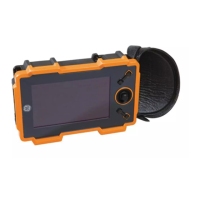Chapter 3. Making Measurements
USM Go Operator’s Manual 83
3.8 Using DAC Mode (Optional)
When displayed, the DAC curve visually represents a line of constant reflector peaks over a range of material depths. Remember that in
DAC mode, the only deviation from traditional display and operation is the appearance of the DAC curve. All A-Scan echoes are displayed
at their non-compensated height. A DAC curve can be based on up to 16 data points (material depths).
A DAC curve is programmed using a series of same-reflector echoes at various depths, covering the range of depths to be inspected in the
test material. Because near field and beam spread vary according to transducer size and frequency, and materials vary in attenuation and
velocity, DAC must be programmed differently for different applications.
The minimum time difference between successive points is 60 ns. This corresponds to a distance of 0.18 mm (0.007 in.) at a velocity of
5900 m/s (.2323 in./s). Successive data points do not have to progressively decrease in amplitude. That is, the DAC/TCG curve does not
have to have a constantly descending slope.

